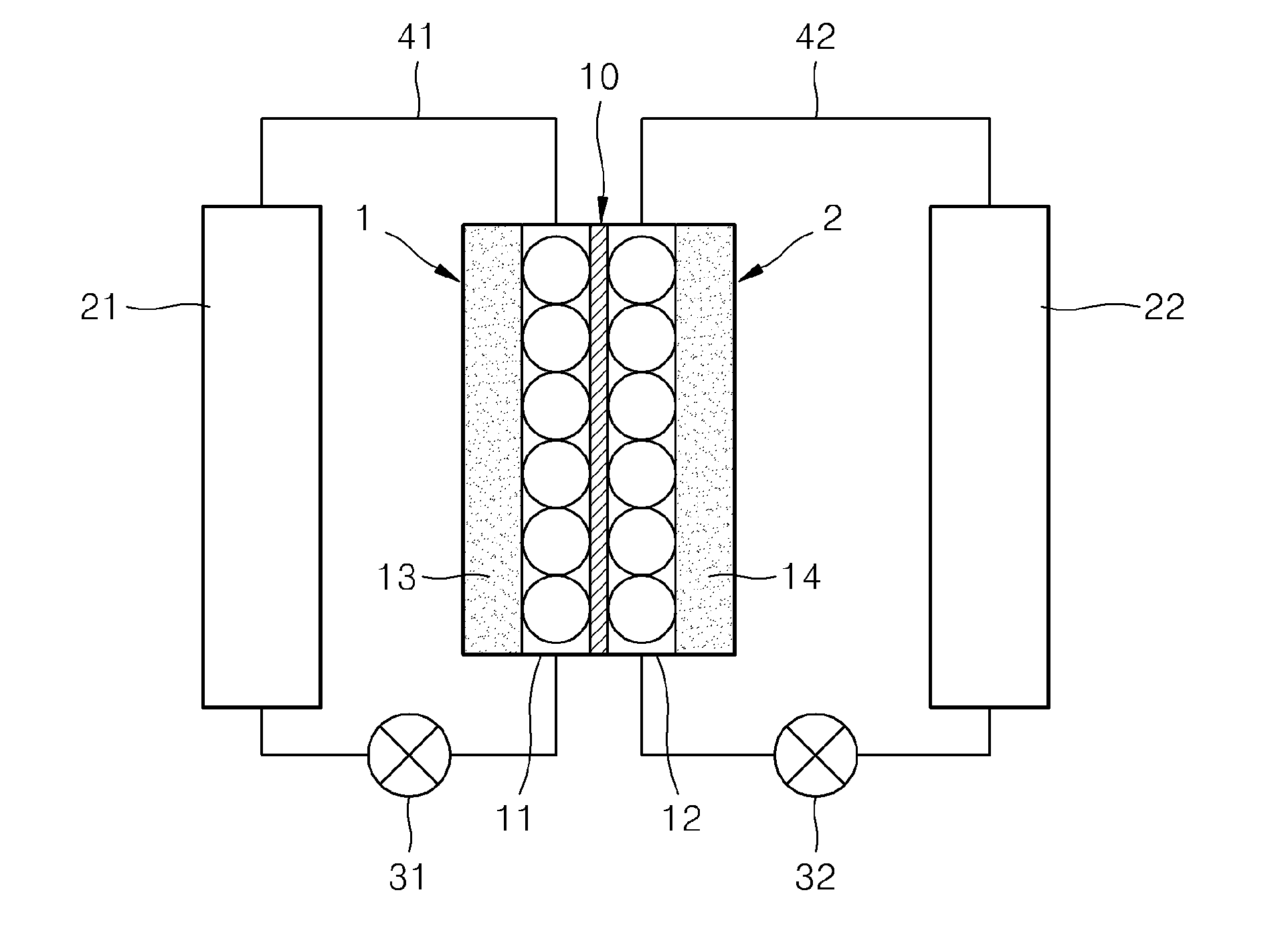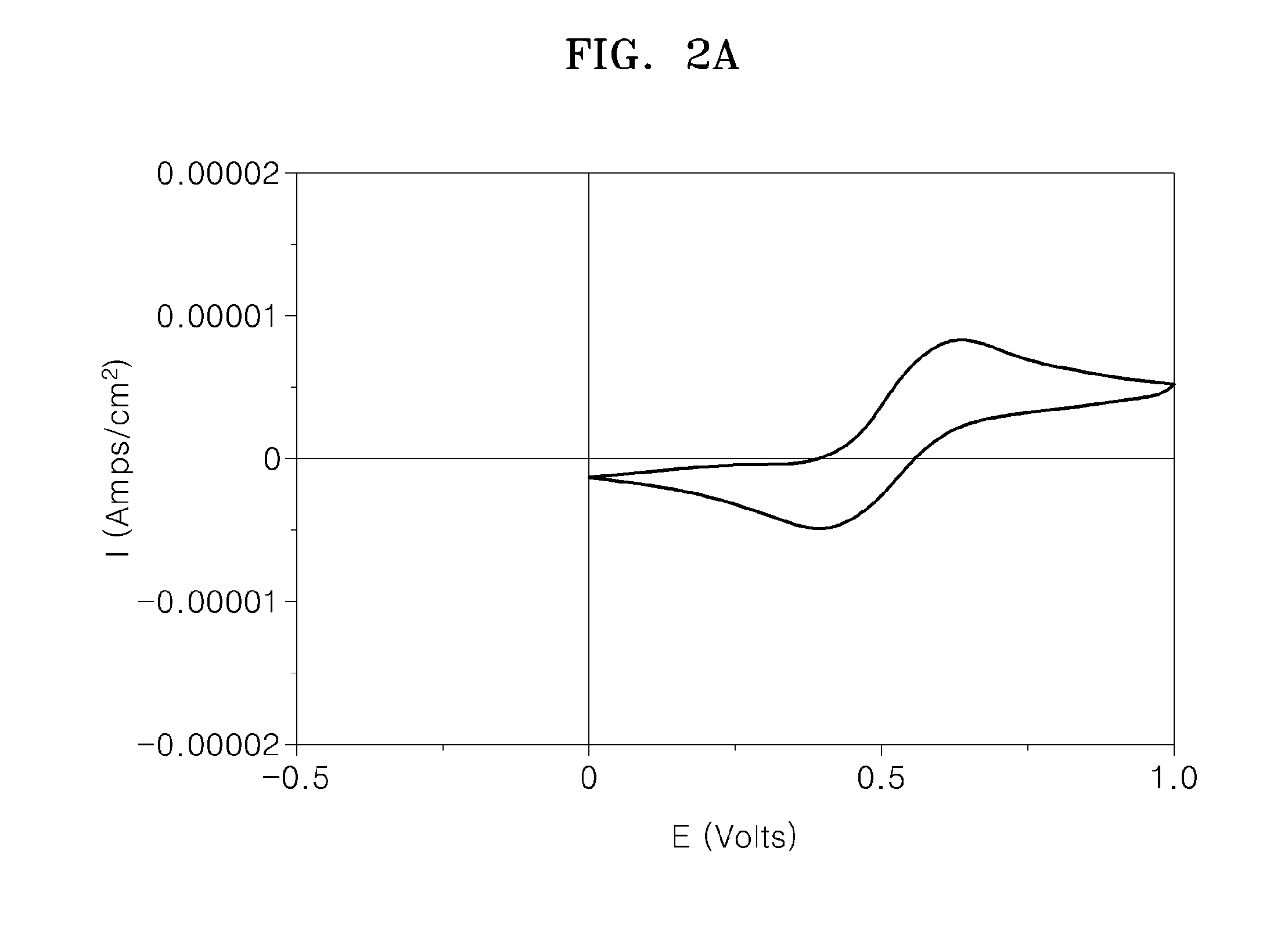Redox flow battery
a redox flow battery and flow technology, applied in the field of redox flow batteries, can solve the problems of low energy density of conventional redox flow batteries using aqueous solvents, and achieve the effects of high energy density, excellent charge and discharge efficiency, and high solubility
- Summary
- Abstract
- Description
- Claims
- Application Information
AI Technical Summary
Benefits of technology
Problems solved by technology
Method used
Image
Examples
preparation example 1
Fe2+-(4,4′-diMebpy)2 (bpy) [TFSI]2
[0076]0.994 g (5 mmol) of FeCl2.4H2O was added to a 100 ml round bottom flask, 50 ml of methanol was added thereto, and the mixture was stirred for 30 minutes until a solution was obtained.
[0077]0.78 g (5 mmol) of bipyridine was added to a 100 ml round bottom flask, 10 ml of methanol was added thereto, and the mixture was stirred for 10 minutes until a solution was obtained.
[0078]The bipyridine solution was slowly added to the FeCl2.4H2O solution, and the resultant solution was stirred at room temperature for 2 hours until the mixed solution gradually turned red. 10 ml of a methanol solution of 1.842 g (10 mmol) of 4,4′-dimethylbipyridine was added thereto, and refluxing was performed thereon at a temperature of 50° C. overnight. 7.56 g (12 mmol) of LiTFSI dissolved in H2O was added to the resulting mixture, and after 12 hours of stirring, the product was filtered and purified by recrystallization to obtain 5.5 g (a yield of 96.4%) of a red solid.
preparation example 2
Fe2+-(5-NO2-phenanthroline)(bpy)2 [TFSI]2
[0079]0.994 g (5 mmol) of FeCl2.4H2O was added to a 100 ml round bottom flask, 50 ml of H2O was added thereto, and the mixture was stirred for 30 minutes until a solution was obtained.
[0080]1.0126 g (5 mmol) of 5-nitrophenanthroline was added to the 100 ml round bottom flask and the mixture was stirred for 150 minutes until a solution was obtained.
[0081]30 ml of an acetonitrile solution of 1.5618 g (10 mmol) of bipyridine was added thereto, and then, refluxing was performed thereon at a temperature of 50° C. overnight. Then, 10 ml of an aqueous solution of 7.56 g (12 mmol) of LiTFSI was added thereto, the resulting mixture was stirred, precipitated, and then filtered to obtain 5.5 g (a yield of 95.3%) of a scarlet solid.
preparation example 3
Fe2+-(terpy)(4′-chloro-terpy) [TFSI]2
[0082]0.994 g (5 mmol) of FeCl2.4H2O was added to a 100 ml round bottom flask, 70 ml of H2O:MeCN=5:2 was added thereto, and the mixture was stirred for 30 minutes until a solution was obtained.
[0083]1.338 g (5 mmol) of 4′-chloroterpyridine was added to the 100 ml round bottom flask, and then, the result was stirred for 60 minutes at a temperature of 40° C. until a solution was obtained. Then, 1.166 g (5 mmol) of terpyridyl was added thereto, and refluxing was performed thereon at a temperature of 40° C. for 12 hours. 10 ml of an aqueous solution of 7.56 g (12 mmol) of LiTFSI was added thereto, and the resulting mixture was stirred at a temperature of 40° C. for 2 hours, precipitated, purified, and re-crystalized to obtain 5.5 g (a yield of 98.4%) of a violet solid.
PUM
 Login to View More
Login to View More Abstract
Description
Claims
Application Information
 Login to View More
Login to View More - Generate Ideas
- Intellectual Property
- Life Sciences
- Materials
- Tech Scout
- Unparalleled Data Quality
- Higher Quality Content
- 60% Fewer Hallucinations
Browse by: Latest US Patents, China's latest patents, Technical Efficacy Thesaurus, Application Domain, Technology Topic, Popular Technical Reports.
© 2025 PatSnap. All rights reserved.Legal|Privacy policy|Modern Slavery Act Transparency Statement|Sitemap|About US| Contact US: help@patsnap.com



